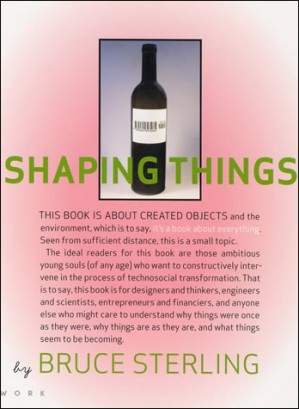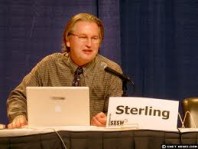Bruce Sterling has drawn the roadmap to the future of manufacturing, where digital modeling and 3D printing morph into Arfid World and spimes.
By Randall S. Newton
 “This book is about created objects and the environment,” says the cover of Shaping Things, (MIT Press, 2005) by Bruce Sterling. “Which is to say, it is a book about everything.” Well, not even an award-winning science fiction author like Sterling can fit everything into 152 pages, but he makes a good try. Sterling connects the dots of design theory, 3D modeling, ubiquitous computing, RFID, GPS, digital fabrication, and more, then passionately colors between the lines to portray the coming world of “spimes” where the blending of design, technology, and metadata creates the objects central to a sustainable future.
“This book is about created objects and the environment,” says the cover of Shaping Things, (MIT Press, 2005) by Bruce Sterling. “Which is to say, it is a book about everything.” Well, not even an award-winning science fiction author like Sterling can fit everything into 152 pages, but he makes a good try. Sterling connects the dots of design theory, 3D modeling, ubiquitous computing, RFID, GPS, digital fabrication, and more, then passionately colors between the lines to portray the coming world of “spimes” where the blending of design, technology, and metadata creates the objects central to a sustainable future.
A brief history of objects
Sterling sees five stages in the history of objects:
• In the beginning was the Artifact, a simple object made by hand, used by hand, powered by muscle. “People within an infrastructure of artifacts are ‘hunters and farmers.’”
• Next came the Machine, a complex precisely proportioned artifact with integral moving parts using a non-human/non-animal energy source. “People within an infrastructure of machines are ‘Customers.’”
• Third is the Product, a widely distributed commercially available object anonymously and uniformly manufactured in massive quantities. “People within an infrastructure of Products are ‘Consumers,’” explains Sterling.
• Fourth, the Gizmo, a “highly unstable, user-alterable, baroquely multi-featured object,” commonly programmable and generally of a brief lifespan. “People within an infrastructure of Gizmos are ‘End Users.’” Gizmos, Sterling notes, “have enough functionality to actively nag people” and they generally exist in relationship to a network.
• Fifth, the Spime, a neologism for “space time object.” Spimes are “manufactured objects whose informational support is so overwhelming extensive and rich that they are regarded as material instantiations of an immaterial system. Spimes begin and end as data. They are designed on screens, fabricated by digital means, and precisely tracked though space and time throughout their earthly sojourn.” The people in an infrastructure of spimes, Sterling postulates, are “wranglers.”
Around each stage formed a techno-culture, a “line of no return” and “a line of empire.” In the Machine techno-culture, Sterling explains, if a sailor from the iron and steam era tries to return to the Artifact era of wood and sail, millions will starve. That?s the line of no return. Each stage of object techno-culture crosses the line of empire when those who lack productive capacity are forced into “colonial or defensive postures” by those who control the means of production.
A busy landscape

Using his five-fold nomenclature as a foundation, Sterling grabs the reader’s hand and and runs through 140 or so elegantly designed pages. It is a busy landscape; along the way you’ll see:
• Design theory and its champions
• The economics of scarcity and plenty
• Mistakes as a source of wealth (think rapid prototyping, then think bigger)
• The haves and have-nots in Arfid World (the economy and sociology of RFID use)
• Transparency, accountability and the power of metrics (How much will you let me know about your product? About your organization? About you?)
• What it means to be doomed to freedom
• Fabbing as the replacement of manufacturing and the future of 3D printing
• How a bottle of Italian Sangiovese wine became gizmo-tized and reached toward spimehood.
When your work boots become spimes, you don’t hunt for them in the closet—or was it the basement?—you Google them. When your car tires are spimes, you can query them to see if your teenager has been abusive. Such novel apps are nice, but not really the point. When running shoes are spimes, you can determine what percentage of the insole has been worn off as micro-particles, what quantity of those micro-particles you may have inhaled, how that compares to every other owner of this particular model of running shoe, and how many of you turn up with a statistically significant specific illness as a result. The accumulating metadata about your running shoes becomes a multi-purpose database of design feedback, consumer preference, medical forensics, and possibly lawsuit fodder.
You think PLM is grandiose in vision? You ain’t seen nuthin’ yet. Uncle Dassault’s PLM is an intentional and private database that documents a process and a product. To the user of a product created in a PLM environment, the database is as assessable and as transparent as a brick on the moon. Uncle Sterling’s SPLM (“splem?” By the way, Sterling never uses the term “PLM”) is a sponge that sucks up every bit of information generated, touched or imagined about an object, and all the information is in the infocloud waiting to be accessed, quantified, pondered, and repurposed.
“Spimes are information melded with sustainability,” Sterling wants you to know. “Spimes are the intersection of two vectors of techno-social development. They have the capacity to change the human relationship to time and material processes, by making those processes blatant and archiveable. Every spime is a little meta-history generator.”
Spimes are designed on screens, fabricated by digital means, and precisely tracked through space and time. They are made of substances that can be folded back into the production stream of future spimes, challenging all of us to become involved in their production. Spimes are coming, says Sterling. We will need these objects in order to live; we won’t be able to surrender their advantages without awful consequences.
There is a bit of quantum mechanics voodoo behind all this. Sterling persuasively argues for the spime-enabled future as a way out of our current toxic landscape. But, like the quantum experiment where the photon changes directions when you look at it, the spime won’t come unless we envision it first, and then it won’t be what we imagine or even design. It can’t be, because in the world of spimes, experience shapes the metadata and then the metadata shapes the experience.
The Sterling behind the spime
Time Magazine called Hugo Award-winning science fiction author, journalist and futurist Bruce Sterling “perhaps the sharpest observer of our media-choked culture working today in any genre.” His “Mirrorshades” anthology of cyberpunk science fiction was must reading in software development circles in the late 1980s.

Three of his novels have been New York Times Notable Books of the Year, and he has been a contributing writer for WIRED Magazine since its conception. In 2005 Sterling was “Visionary-in-Residence” at Art Center College of Design, Pasadena, California; “Shaping Things” came out of that experience. When not traveling on assignment, he divides his time between residences in Austin, Texas and Belgrade, Serbia.
This review originally appeared in the April 2007 edition of Engineering Automation Report, acquired by Jon Peddie Research in 2010.





